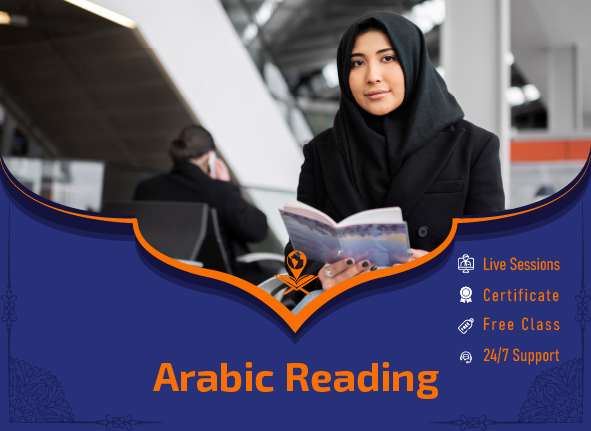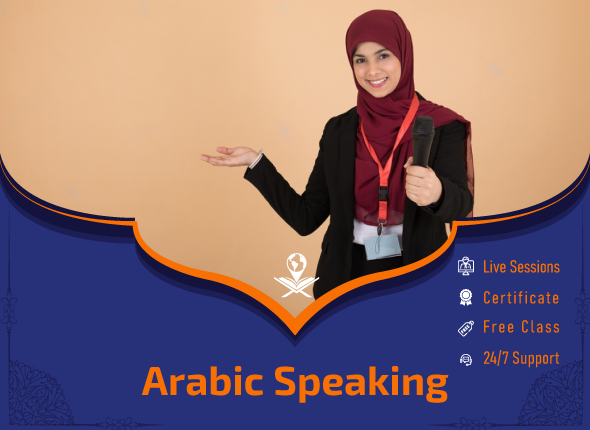
Arabic Reading Course
Course Description
Arabic reading with our platform is different because we follow the latest methods and modern ways that will help you learn to read Arabic and motivate you to learn Arabic reading with ease.
This course will help you to read and pronounce Arabic correctly, Arabic reading course is your way to learn Tajweed and the other Islamic religious sciences, also the right pronouncing of the Arabic letters will help you and your children to communicate easily with Arab, we will begin by the articulation and phonetics, and the course will be ended by fluent Arabic readers.
What You’ll Learn From This Course
- Gradual learning is the first thing that is Arabic alphabet reading and reading Arabic numbers.
- Then addressed in education is to distinguish between syllables of small and long letters, meaning distinguishing between the three long vowels and the vowels, reading, and writing, so that all the letters of the Arabic language are preserved, including the three long vowels.
- Then Writing each letter of the Arabic language with the three letters of madd in sequence until all letters are written, then do tests in that.
- Writing each Consonant with each letter of the language in sequence until all the letters are written with the movements, then testing the learner in that, and the reason for this is due to the students mixing between the letters of the extension, which is the essential basis in the learning process.
- Distinguish between nun static and tanween.
- Gradual mention of the terminology of grammar, in proportion to the level of the learner, with various examples, always multiple.
- Ask the learner to write some examples.
- Provide easy language stories for the learner, with elements such as ease, suspense, and sequence.
- Learning through groups, where students are divided into groups, and each group is assigned specific learning activities. Encourage simple expression so students express themselves by writing examples of what they have learned from the vocabulary.
- Ask the learner to write some examples.
- Provide easy language stories for the learner, with elements such as ease, suspense, and sequence.
- Learning through groups, where students are divided into groups, and each group is assigned specific learning activities.
- Encourage simple expression so that students express themselves by writing examples of what they have learned from the vocabulary.
- Since the Holy Qur’an is the preserver of the Arabic language, one of the fields of learning can be the learner’s connection with the Holy Qur’an so that he is taught to read it from cover to cover since doing so is both worship and education.
Arabic reading lessons for beginners
Arabic reading lessons for beginners in the Arabic language are essential to expanding your knowledge. Then you can learn anything about the language by referring to books and texts.
Learn the alphabet from A to Z to have a sound foundation for learning the Arabic language. This course will include a special video for each letter to teach you how to fluently write and pronounce all the letters of the Arabic language.
We will begin our Arabic lessons online with you from the beginning level, and we will lead you to an expert and fluent level.
-
- We will begin with the alphabetic letters, by modern standard techniques such as Noor Al-Bayan.
- Phonemic awareness to recognize the sound of each letter,
- Articulation sound to pronounce each letter in the right place, this is very important for Quranic Arabic.
- Arabic diacritics, which are “Al Fath, Al dum, Al Kasr, Al Sukun, Al Shadah, Al Tanween”
- Listening lessons
- Arabic words building, segmental phonology, and Arabic word syllables.
- Words reading, And Quranic Arabic reading.
ABOUT THE COURSE
There are many strategies and theories through which you can learn to write and read, but not all of these methods are suitable for all people.
There are theories that work for one and not the other.
Therefore, the individual’s IQ should be determined first, on the basis of which the appropriate strategy is selected.
Have you ever asked what is the feeling when you read the Quran from the Holy Quran in Arabic? How does it differ from transliteration? “Read” is the first word that was revealed to the prophet Muhammed PBUH, being a Muslim you should learn to read the Arabic Language correctly to be able to recite the Quran.
ِArabic reading course is very important to learn Tajweed and read as the prophet Muhammad PBUH was reading, you have to learn the Arabic language, Articulation, and Phonetics to pronounce and read Quran correctly.
Learning Arabic will help you to learn the Islamic religious sciences like Aqida, Fiqh, Tafsir, and Hadith in Quranic Arabic. Learning Arabic online classes will help you to read and understand Islamic terminology in the right way.
Are you in an Arabic country and want to learn about their culture? What is the secret of the beautiful Arabic rhythm, why non-Arab can’t read some Arabic letters?
In the Arabic reading course, with our native, qualified, and certified Arabic teachers, we will seal in the beauty of the Arabic language, they will teach you and your children to read and pronounce Arabic correctly with the right and easy techniques, and you will find your Arabic teacher or Arabic tutor to begin your journey in the modern standard Arabic lessons.
WHY TAKING THIS COURSE
Best way to learn to read Arabic for children and beginners with Arabic reading class:
Strategies for learning to read The strategies that help in learning to read can be summarized as follows:
Fitzgerald’s strategy:
In which the teacher does the following:
- He reads the letter to the child and makes him pronounce his name.
- Makes the child look at the written letter.
- Then he is asked to close his eyes and imagine the shape of the letter.
- Then he hides the letter from the child and asks him to write it without looking at him.
- If the student makes a mistake, he will repeat it again.
Orton Gillingham’s strategy:
- In which the link between the letter and the sound is made as follows: Trace, the purpose of which is to know the shape and arrangement of the letter, as well as it’s sound.
- Transliteration; develops visual memory in children.
- Then the teacher asks the student to read the text he wrote.
- Horn’s strategy: This strategy is based on the following: The student pronounces the word correctly. And to look at its parts during its pronunciation.
- To include the pronunciation of the word from the part to the whole. He closes his eyes and imagines the word, and spells it.
- Then he looks at the word again. And then he writes it down.
- The hierarchical method, in which the teacher does the following: Read the word clearly to the pupils.
- Then he analyzes it.
- The child reads the letters of the word with diacritics.
- Then the word is divided into groups.
- The child reads the groups sequentially and then says the word in its entirety.
- Closing strategy, in which the teacher does the following: Presents the word to the child. To read the letters, ask the youngster.
- And then displays the word and deletes the letter tide.
- Then the child completes the missing letter.
- And then write the whole word.
- The most important of all these steps is the way or method that the teacher follows in communicating the information to the learner.
- The teacher should have the means to motivate and encourage learning and the learner to read and write by clarifying the benefits of reading Arabic in their lives, so we have the best teachers to help you with that.







